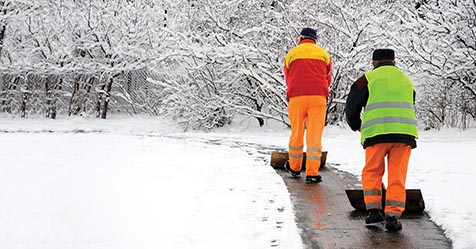In some end user circles, productivity is the leading industry buzzword of the day.
Managers and owners need to know how to motivate employees, task appropriately and get better cleaning results.
While there are many training products and consultants on the market today, many of which can be of great assistance, a strict cleaning strategy can help organize the workload in order to achieve desired results.
Over the years, Team Cleaning and Zone Cleaning have become popular cleaning strategies.
And, the debate between Day Cleaning and Night Cleaning still lingers as to which provides more benefits.
Today, according to the experts we’ve interviewed, equipment innovations as well as industry trends, such as green cleaning, have positively affected cleaning strategies and productivity.
The team approach
Depending on the facility”s needs, a Team Cleaning strategy is typically comprised of numerous workers, according to Jim Harris, Sr., who is the CEO/president of Concepts4 Cleaning Consultants.
In a Team Cleaning model, says Harris, numerous specialists work independently of each other:
- Light-duty (starter)
- Vac (closer)
- Restroom (sanitor)
- Utility 1, 2, 3, 4 (such as cleaning stairs, carpet spotting, specialty cleaning, etc.).
“Each specialist”s role involves specific tools and tasks as well as performance standards that are known and measureable, using a checklist system,” says Rich Parillo, building service contractor specialist at Pro-Link, a JanSan-focused marketing and buying group.
According to Harris, workers in a Team Cleaning model stay productive through communication and written instruction.
“[Each worker] is equipped with the following: Equipment specific for the assigned duties; job card (routing-duties-quadrants-time) which shows where to go, what to do and how long it should take; and a note pad for communication,” notes Harris, who adds that productivity can be modified by simply changing the job card.
In order to be successful, Team Cleaning workers and managers must be properly trained.
“To the untrained manager, Team Cleaning is confused with Gang Cleaning, which is where every cleaner works together [in one area at once,]” says Harris. “This could not be farther from the truth.”
Zone coverage
In the Zone Cleaning model, one employee typically performs all of the tasks for a specific area.
This system gives the worker a sense of “ownership” for the entire area.
Also, according to Daniels Associates Inc.”s CEO Ian G. Greig, the Zone Cleaning model enables the worker to clean at his/her own pace.
A concern with Team Cleaning, says Greig, is that “people have to slow down, literally, to the speed of the slowest cleaner, which is not productive at all.”
An industry consultant, Greig offered a modified version of Zone Cleaning, referred to as Task and Frequency Cleaning.
“Zone Cleaning is efficient because you use [more of] the equipment on the market today, which allow [users] to get up to rates of 10,000 square feet an hour,” says Greig, who recalls breaking into the industry many years ago when end users were satisfied with cleaning 1,600 square feet an hour.
Day versus Night
For years, the preferred cleaning hours in commercial cleaning were during the night.
However, this preference is changing.
“If for no other reason, [Day Cleaning] can save building owners money due to less electrical costs,” says Parillo. “Keeping a building up and running 24 hours per day is getting more and more costly, especially when half of those 24 hours is just to keep the lights, HVAC systems and other building mechanicals running for the cleaning staff.”
Greig notices other benefits that can result in additional cost savings.
In an office setting, for example, daytime cleaners often develop a rapport with the building”s occupants and visitors.
This achieves cost savings in several ways, including:
- Communication lines remain open
- The cleaner better understands each individual”s cleaning needs
- The cleaner is kept abreast of new and terminated employees, which might add or subtract to the workload
- Building occupants are more inclined to pick up after themselves.
“Unfortunately, there are huge layoffs [happening in corporate America] today,” asserts Greig. “The night cleaner might have no idea that Mary isn”t working in her cubicle any more and can come back to the client with a revised [fee] based on requirement.”
This communication also greatly impacts worker productivity.
The labor issue and notable trends
Labor is a BSC”s or in-house manager”s number one cost factor.
And, since better products and more efficient equipment are available, these managers and owners can now look to reverse the trend.
“We are an 80 percent labor-intent business, with six to eight percent for equipment,” says Greig, who notes that this ratio is unmatched in any industry. “We have to look at equipment replacing labor and raising the amount of equipment used and lowering the amount of labor required. Historically, we have not done that.”
In addition to performance and reduced noise, today”s cleaning equipment is considered greener, which can also help productivity rates.
And, an indirect benefit of a facility”s green initiative, customers are open to new ideas, such as unnecessarily removing trash from cubicles and offices every day of the work week — another productivity builder.
Final factors
Variables to consider when looking to implement a cleaning strategy or shift working hours include the building”s size, its layout and any extraordinary needs, such as special events.
“It all starts with determining cleanable square feet and drilling down to best methods — labor, tools, schedules, [etc.] — that will optimize cleaning,” adds Allen Rathey, president of InstructionLink/JanTrain Inc. “[Remember,] small changes in scheduling can make a big difference. Identify the critical from non-critical cleaning areas and frequencies; skip the non-critical and focus on the critical.”
To increase productivity, Rathey also asks cleaners to look in the mirror with an open mind.
“During a shift analysis, make sure workers get started working right away and make them accountable. Often, 15 minutes per worker is lost just getting started at the beginning of the shift,” says Rathey.
Regardless of the cleaning strategy or the worker”s habits, without standardization and accountability, warns Harris, cleaning workers cannot validate true productivity rates.
“The industry discussion of productivity is becoming meaningless and grossly misunderstood,” says Harris.
However, adds Harris, when looking to improve morale and keep workers focused, select a system based on the following factors:
- System drives the work
- Incorporates effective equipment, which requires fewer units
- Has inspection built into the system.
Every manager and owner is looking to save a buck today. Take notice of employees” work habits and explore different cleaning strategies based of your facility”s needs.
How fast can you see results in productivity by switching to a strict cleaning strategy? “Literally, immediately,” concludes Greig.


